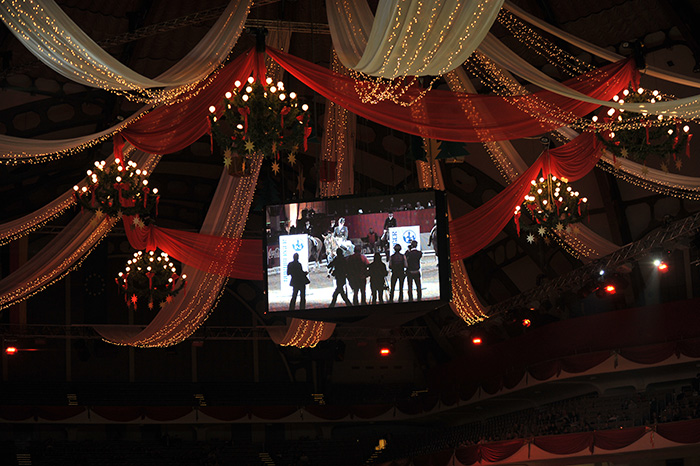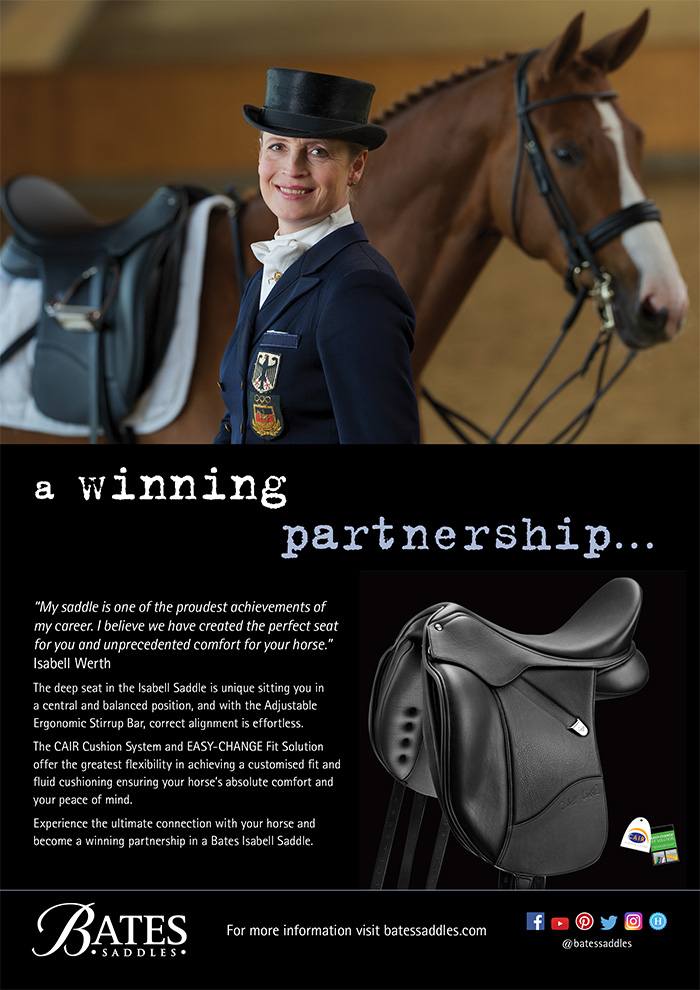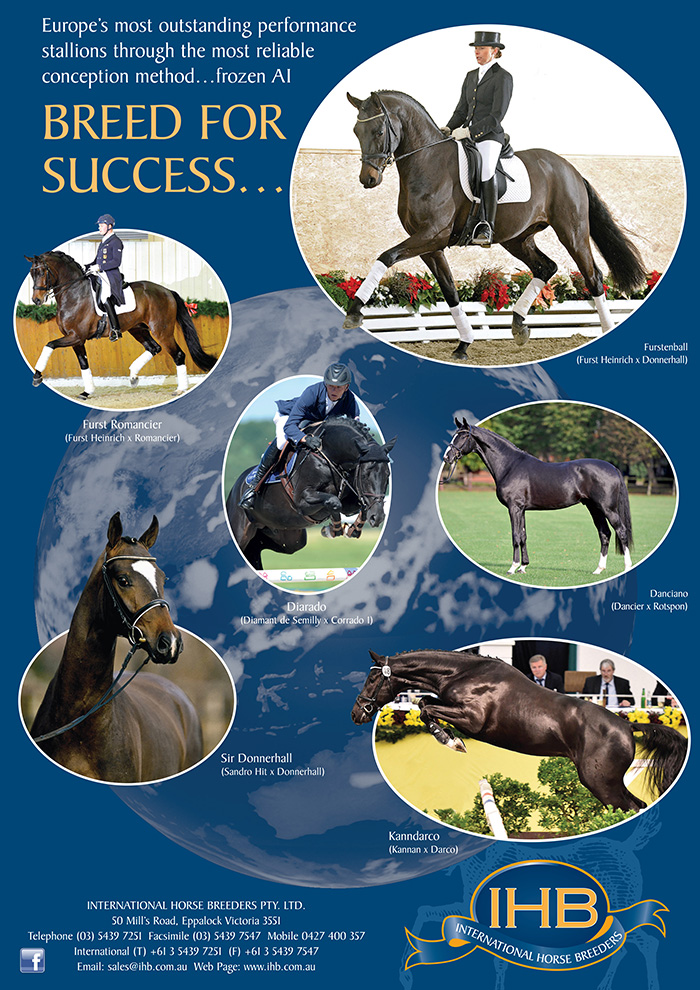Story – Christopher Hector Photos – Kenneth Braddick and THM files
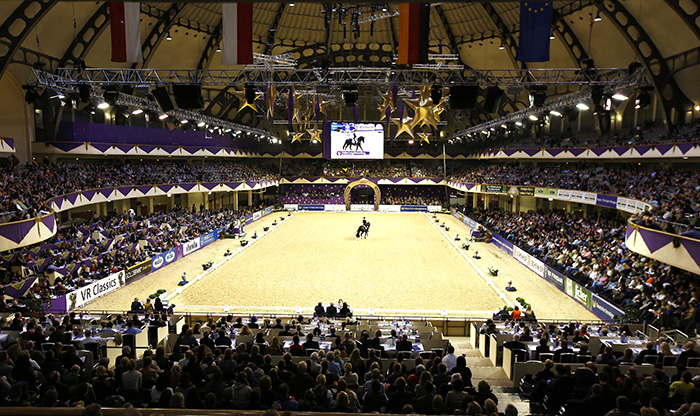
For a long time, the trade in dressage blood flowed from Germany to Holland, now it seems the tide has turned and German breeders are increasingly using Dutch blood. This trend can clearly be seen at one of the world’s great indoor shows – Frankfurt – and in the Nürnberger Burg-Pokal, a prestigious class for horses aged 7 – 9. The moving force behind the competition was the late Reiner Klimke. He wanted a competition to bridge the gap between Prix St Georges and Grand Prix, and the horses compete in a modified Prix St Georges test, after qualifying in a series of tests held all over Germany.
Interestingly, the German horses that were used to establish the Dutch dressage horses came not from the heartland of dressage breeding, Hanover, but from the jumping bloodlines of Holstein. Thus, still the most influential Dutch dressage stallion, Jazz is by Cocktail, out of a mare by Ulster.
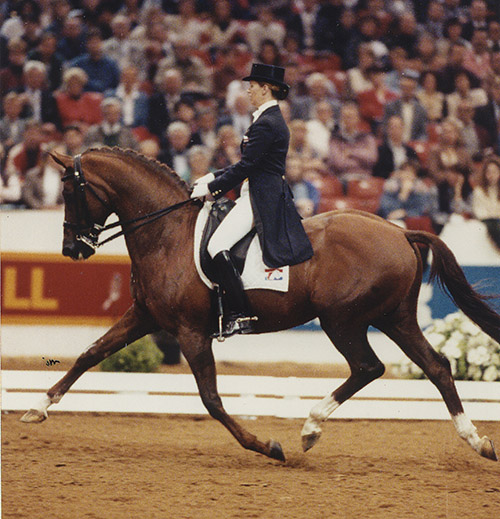
Cocktail and Anky van Grunsven in the competition arena
Cocktail was a Grand Prix dressage competitor but there was little in his pedigree that would indicate that. Cocktail’s sire, Purioso, like his sire, Furioso, was a genuine all rounder, he bred as many jumpers as he did dressage horses, but that’s about it. Cocktail is out of a mare by the Thoroughbred, Le Val Blanc, and Jazz is out of a mare by a son of the great jumping sire, Nimmerdor, out of a mare by one of those towering hunks from Holstein, Amor.
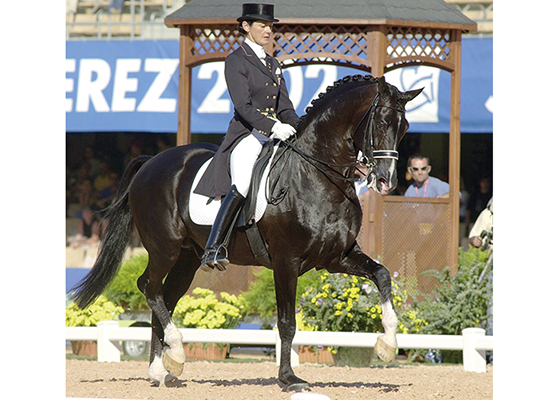
Ferro and Coby van Baalen in the Dutch team in Jerez in 2002
That other pillar of Dutch dressage breeding, Ferro, is by Ulft by the French sire of jumpers, Le Mexico, out of a mare by another Holsteiner tank, Farn. Indeed, Ferro commenced his career as a showjumper before he found his niche as a Grand Prix dressage horse.
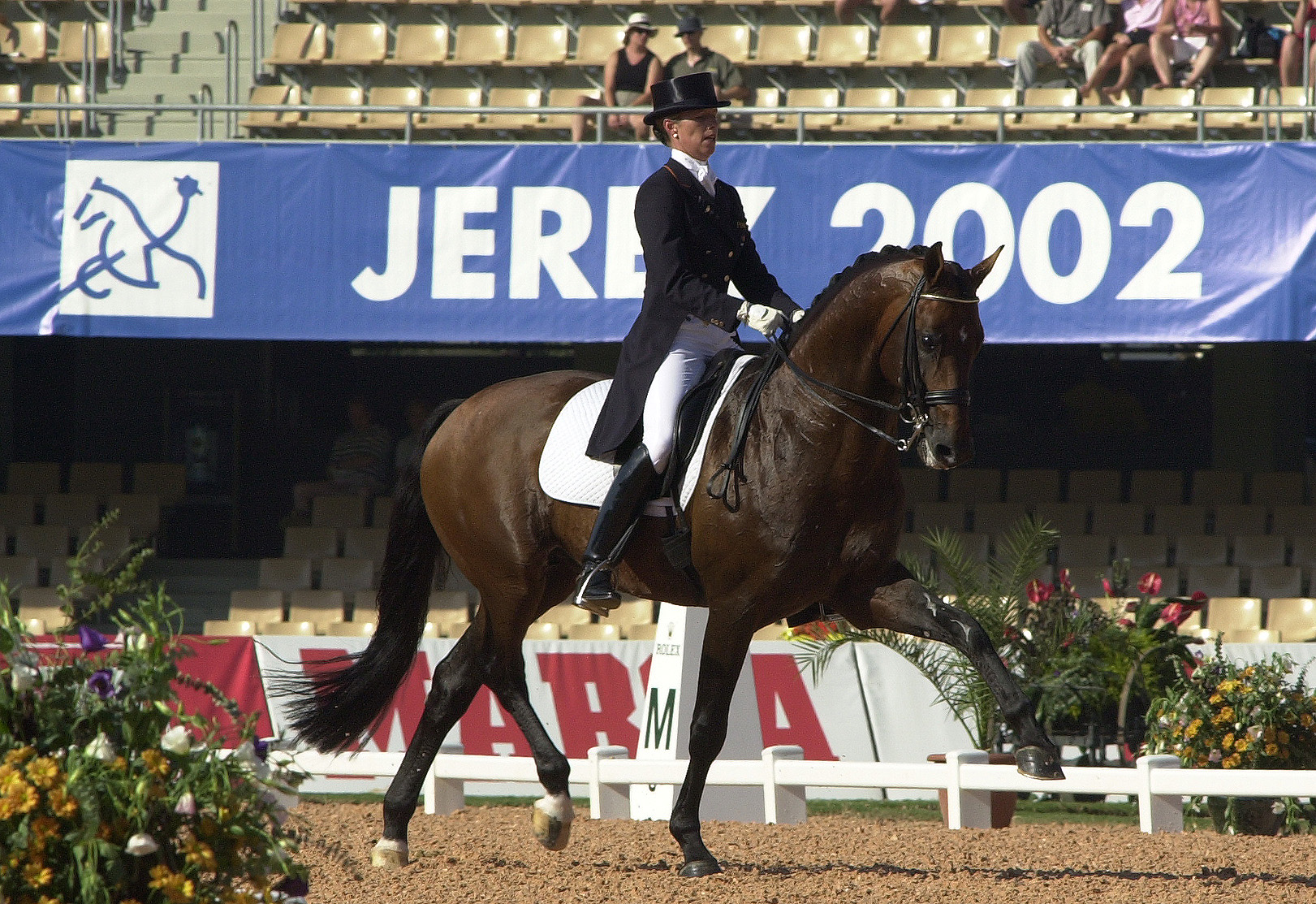
Another member of the Dutch team in Jerez, Krack C with Anky van Grunsven
Similarly, Krack C’s career as an international dressage competitor, would seem to have little to do with his breeding. His sire, Flemmingh is straight jumping Holsteiner, while his dam is by a son of the influential Thoroughbred sire of jumpers, Lucky Boy.
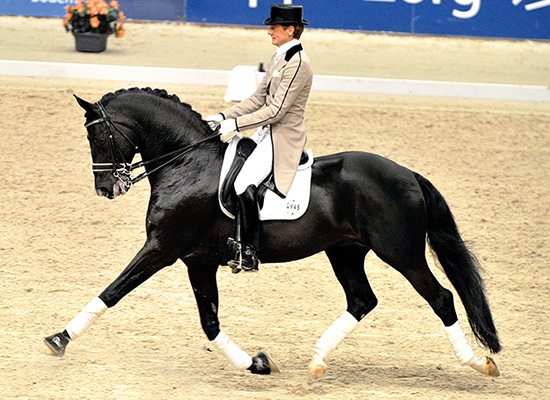
Gribaldi at his farewell with his Grand Prix rider, Edward Gal
More recently the German Trakehner, Gribaldi, has been an influential sire in Holland, he is more conventionally bred for dressage, although there is precious little by way of any sort of performance on his pedigree.
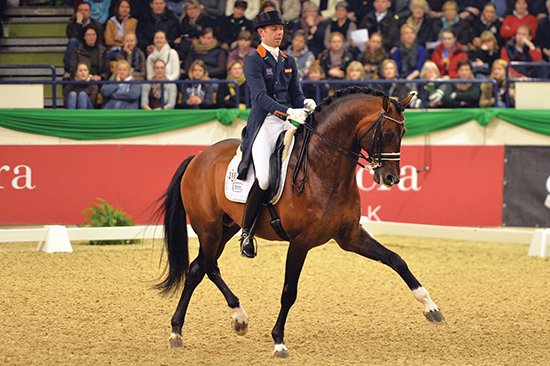
Johnson with Hans Peter Mindenhoud, Grand Prix winner
I find it interesting that the first three, bred to jump, became fine Grand Prix horses, yet none of their sons, bred for dressage, including some superstars of the licensing, went on to be a top Grand Prix horse, with the notable exception of the Jazz son, Johnson (out of a Flemmingh mare). Of this more later…
Now it would seem that while the wilder predictions of a Dutch invasion have not come true, certainly blood from the Low Countries is reaching even the elite levels of the Burg-Pokal finalists.
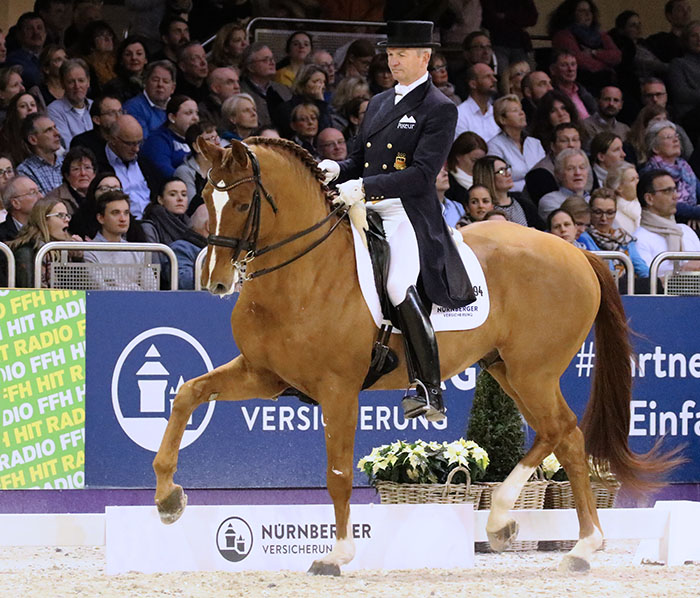
Hubertus Schmidt and Bonamour in 2018
Thus we had Hubertus Schmidt riding Bonamour.
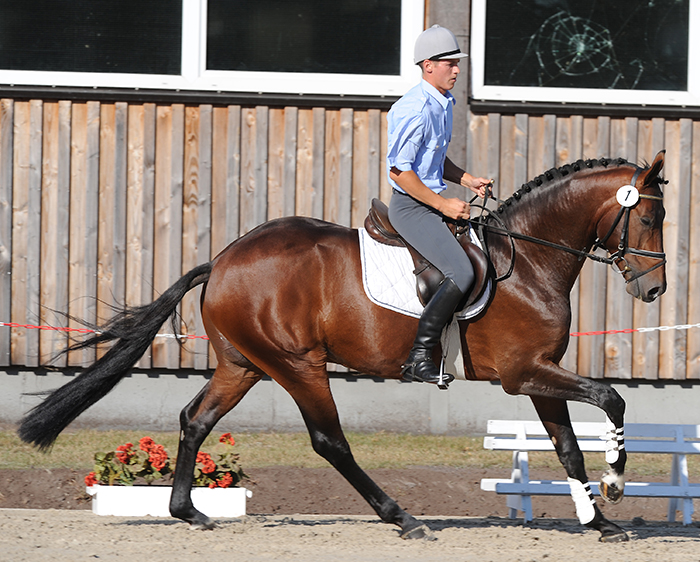
The Hanoverian stallion Bonifatius as a young horse
Bonamour is by the Hanoverian stallion Bonifatius (Belissimo / Lauries Crusador). The dam was by Rousseau (Ferro / Römer), albeit out of a mare by the stalwart of Hanoverian breeding, Werther.
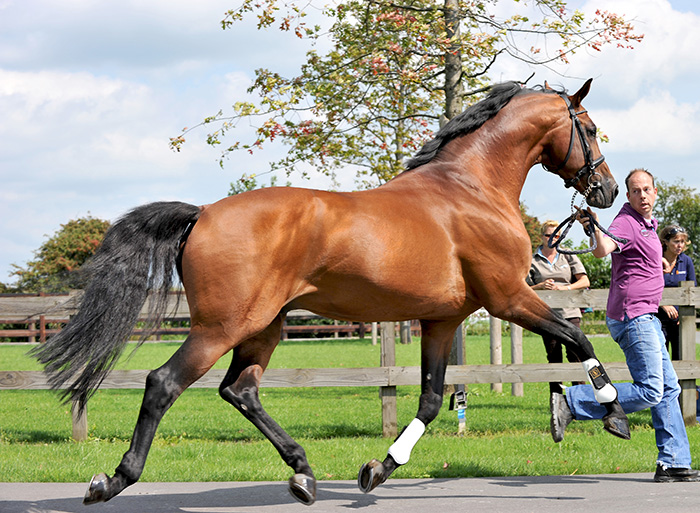
United, adding Dutch to the mix
Then we have Bluetooth, a curious mix of Dutch and German Warmblood aristocracy, and born on Paul Schockemöhle’s Gestüt Lewitz. Bluetooth is by the Dutch stallion, Bordeaux, who is by United who is by Krack C out of Nessica, a daughter of another Dutch Grand Prix stallion, the Trakehner, TCN Partout. Bordeaux is out of Venna, by Gribaldi.
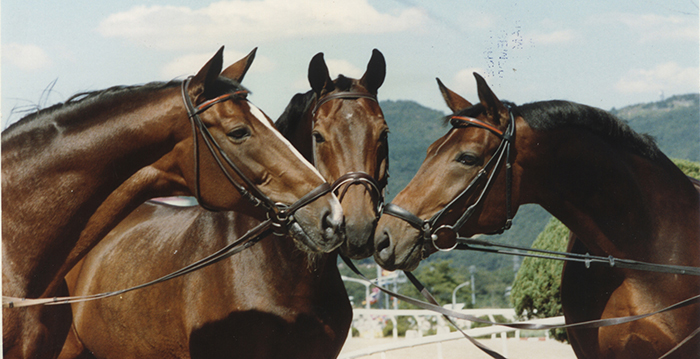
And the German side of the mix – At the 1998 Olympics in Seoul, left Ahlerich, a member of the German Gold Medal Team with Dr R Klimke, centre, Amon competing for Holland with Annemarie Sanders Keyzer, and Rembrandt, Individual and Team Gold with Nicole Uphoff. Photo taken by the late Werner Ernst at the Trot Up.
Venna is out of Leandra M by Donnerhall, out of Roussina, by the German Rousseau (Romadour II / Lugano II) out of the very famous mare, Adone (Angelo xx / Donar) who was the dam of Uphoff’s superstar, Rembrandt, out of Dodona, dam of two Olympians, Adone and Ahlerich, and the grand-dam of Rubinstein. Wew! But there is even more royalty lurking in the papers…
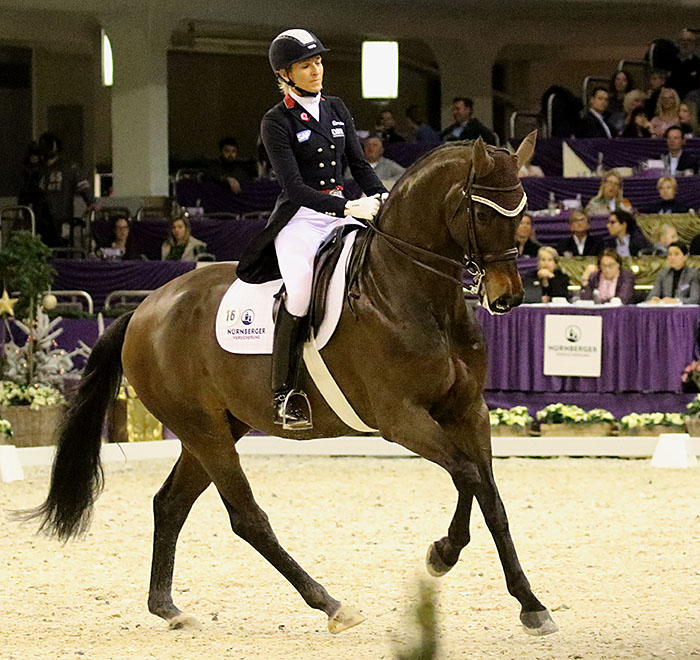
Bluetooth’s dam is Ravissant by Riccione who is by the Rubinstein son, Regazzoni, out of a mare by the Trakehner, Arogno, out of a mare by the founder of today’s influential ‘B’ line, Bolero. It gets better on the final line, Ravissant is out of Loreana (by Don Schufro) out of the Queen of Paul Schockemohle’s mare band, Loretta (Ramino / Welt As) who is the dam of Sandro Hit and Diamond Hit.
That pedigree is the bloodline geek’s ultimate fantasy, and really only goes to show that you can’t ride the paper. Bluetooth himself is a most unimpressive creature, very long and flat, strung out behind in the trot, and seemingly too weak behind to take the weight and collect in the canter – along with a wickedly lateral walk. In the first round of the Burg-Pokal, despite having Ingrid Klimke in the saddle, it was a very poor test, but again perhaps because of having Ingrid in the saddle, the gelding scored two 74’s, while Dietrich Plewa viewed it more soberly for a 69…
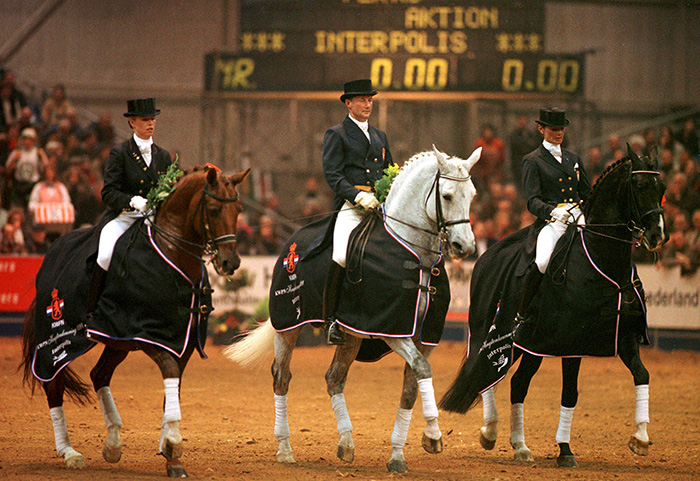
The big three for Holland, Cocktail and Anky van Grunsven, Gulya Dallos and Aktion, Ferro and Coby van Baalen. Jacob Melissen image.
Susan Pape rode another Dutchy, Harmony’s Eclectisch, by a son of the Dutch-bred Rousseau, Zenon who is out of a mare by the 1.50m metre showjumper,Whinny Jackson, who has all the big three in his breeding: Farn, Amor and Nimmerdor. Harmony’s Eclectisch is out of a mare by the Jazz son Olivi, who is out of a mare by the Dutch bred, international dressage competitor, Aktion. Sadly, the harmony was only in the prefix, and the horse’s test was marked by a flurry of tail swishing. In truth, all three of the Dutch bred horses showed this fault in varying degrees of intensity. In the past I had always assumed that this was a product of the Dutch riding style, but when you have this same result with three elite German riders, Hubertus, Ingrid and Susan, then you start to wonder – is it a heritable trait?
Have the Dutch breeders in their search for elegance and refinement produced horses that lack the power for dressage at the highest level, horses that indicate they are finding it tough going by swishing their tails? I can remember talking to the judge and stallion assessor, the late, and still sorely missed, Wim Ernes, when I suggested that given so many of the Dutch licensing champions failed to make it to Grand Prix, perhaps breeders might look to Breitling, who produced so many Grand Prix horses out of so few mares, and Wim said, oh no, the Dutch breeders would not use him because he is not a nice type.
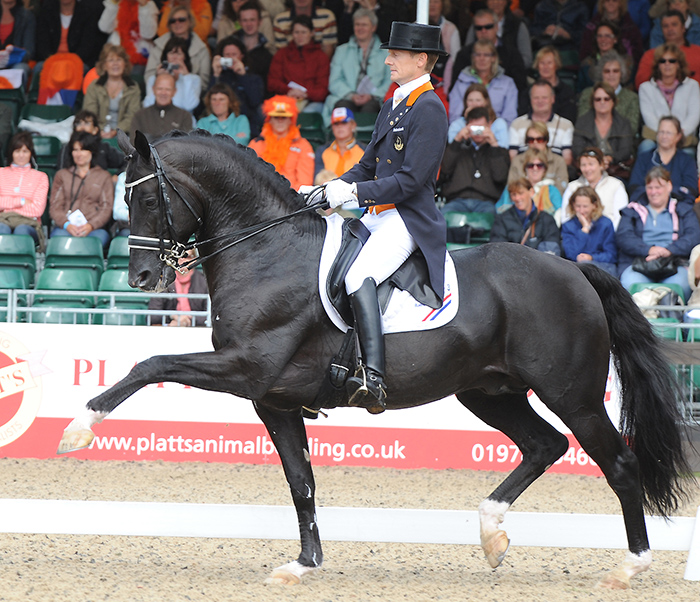
Totilas and Edward Gal at the Europeans in Windsor in 2009
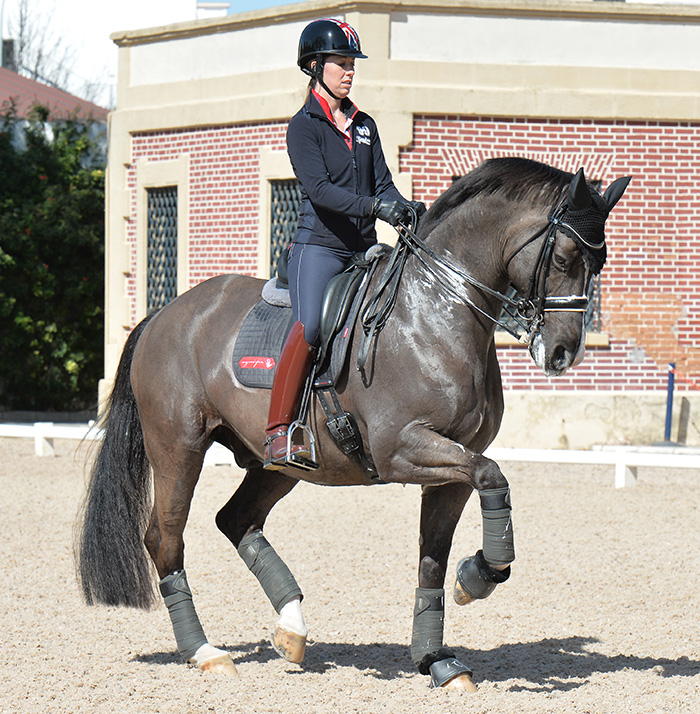
Valegro preparing for Rio, his final appearance, in 2016 – Carl Hester told us: “Anyone who saw him as a four, five or six-year-old, remembers he had a very strong, Cobby trot, there wasn’t the sort of power and expression he has now.”
But when you consider that neither Valegro nor Totilas, the two most successful Dutch horses of recent times, were that modern super elegant type, perhaps a bit of old fashioned substance and power, are necessary for the Big Sport.
Three out of twelve starters possess some level of Dutch blood, 25%, that represents a significant thread in modern German breeding, it will be interesting if the Dutch trend gains strength, or is just a passing fad. All those breeders who parted with huge sums of money to breed to Totilas may now be ruing their haste to get on the bandwagon, if the results of the mare tests and licensing inspections in the latest Hanoverian stallion book, are anything to go by. The progeny score a negative 94 for type, 85 for head, 93 for neck, 84 for saddle position, only moving into positive territory for frame, 110, and breed and sex type, 106. Totilas also scores a negative 98 for correctness of conformation. What will hurt worse is that his progeny score a negative 99 for dressage ability, with an embarrassing 82 for rideability. Not surprisingly, Totilas’ stud fee dropped from €8,000 in 2010, to €2,500 six years later.
The debate will go on forever over the worth of young horse classes as a predictor of future glory at the top level. But the Nürnberger Burg-Pokal, is an established gold mine. Since the event started in 1992, the winners have claimed eight Olympic gold medals, five silver and four bronze.
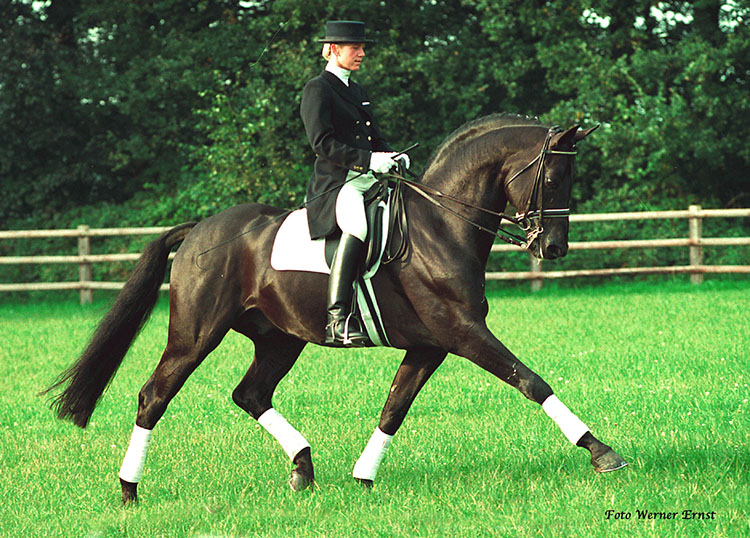
Rubinstein and Martina Hannover, Burg-Pokal winners
The winners include Rubinstein (Rosenkavalier / Angelo xx, 1994), Chacomo (Calypso I / Marmor, 97), Relevant (Rubinstein / Goldlöwe, 98), Bonaparte (Bon Bonaparte / Consul, 01), Wahajama (Warkant / Acapulco, 02), Elvis (Espri / Garibaldi), 04), Whisper (Welt Hit I / Weltstar, 05), Augustin (August der Starke / Rohdiamant, 07), El Santo (Ehrentusch / Rhythmus, 08), Blind Date (Breitling W / Donnerhall, 09), Weihegold (Don Schufro / Sandro Hit, 13) and Vitalis (Vivaldi / D-Day) in 2016.
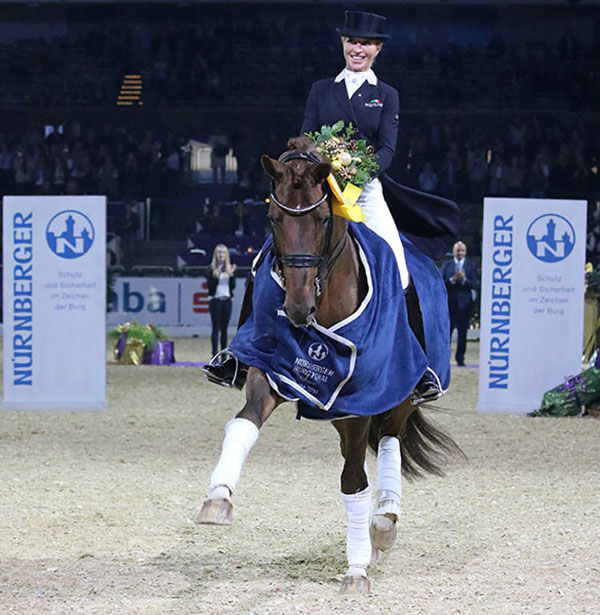
The Dutch stallion Vitalis makes the honour roll, not because of his competition career, which stalled at small tour level, but because he is currently well-and-truly the flavour of the month in Germany. Vitalis dominated the October Hanoverian licencing with six of the 12 premium stallions, carrying his blood, three own-sons, one of which, out of a Dancier mare, sold for €2,010,000 to the new power bloc, Schockemöhle / Helgstrand. A month or so later, American horse breeder, Leslie Malone added to the hysteria at the PSI auction when she bought V-Plus (Vivaldi / Fürst Romancier) for €1,200,000.
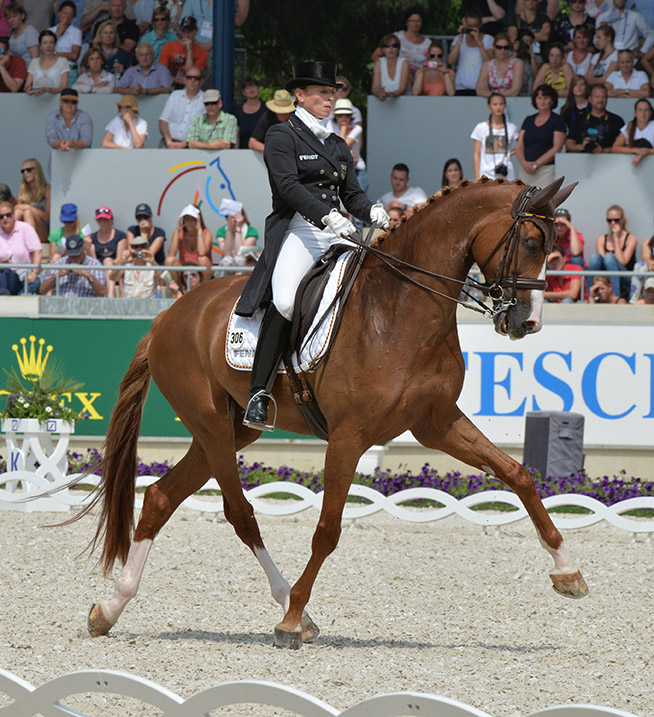
Bella Rose, one of the many successful starters for Isabell Werth
Horses that made the final in the past, but did not win the class who went on to glory include: Farbenfroh (Freudantanzer / Aarstein), Beauvalais (Bolero / Grande), Diva Royal (Don Frederico / Warkant), Desperados FRH (De Niro / Wolkenstein II), Damon Hill NRW (Donnerhall / Rubinstein), Showtime FRH (Sandro Hit / Rotspon), Piccolino (Prince Thatch xx / Ganymed I), Renoir (Rubinstein / Winston), Warum nicht FRH (Weltmeyer / Wenzel I), Sterntaler-Unicef (Sion / Manstein), D’Agostino FRH (De Niro / Shogun xx) and Bella Rose (Bellisimo /Cacir aa).
The 2018 crop follows
The winner, Dorothee Schneider’s gelding First Romance (Fürst Romancier / Day Dream) is strongly dressage bred.
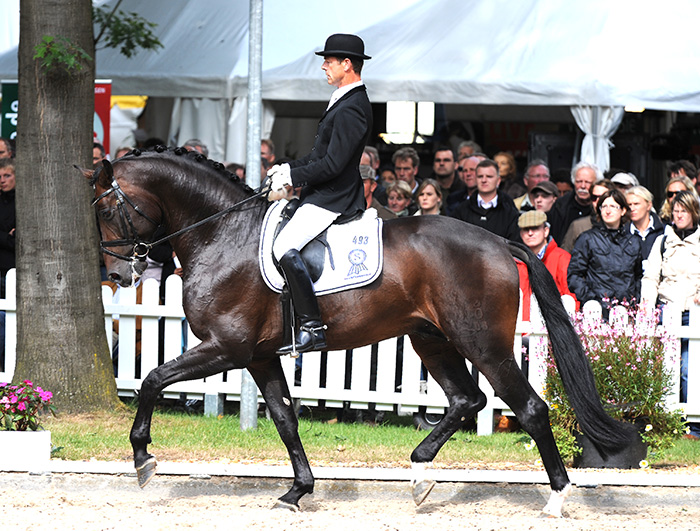
Fürst Romancier competing at the Bundeschampionat
His sire is by Fürst Heinrich, a classic cross of Florestan over a Donnerhall mare. Fürst Heinrich won the Five-Year-Old World Young Dressage Horse championship back in 2003, then died before he had the chance to go on and prove himself at higher levels. Certainly he proved himself a very successful sire in his short breeding career. In the line-up of this year’s Burg-Pokal finalists, he is represented a second time by Die Fürstin, by Blue Hors Don Romantic out of a Fürst Heinrich mare.
Fürst Romancier is out of a Romancier (Rosenkavalier / Feuerschein I) mare. Romancier was one of the very first sires at the Blue Hors stud.
First Romance is out of a mare by Day Dream, who competed modestly at Grand Prix level with Katrin Burger. Day Dream is by Don Gregory (Donnerhall / Graphit) out of a Trakehner mare by Schwärmer. There’s more ‘R’ on the final line, First Romance’s dam, Donna Rubina D is out of Rubina by Rubinstein.
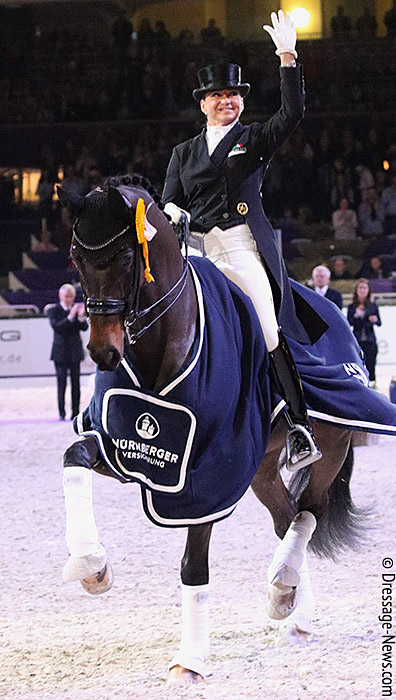
Dorothee Schneider and First Romance looked menacing in the warm up class, when they were second, and in the final, when it counted, turned it right on. The trot is so engaged, the walk is so clean, there is a little moment in the first canter pirouette when the weight shifts to the outside leg, and the second is a little tense, but the rest of the test is sublime. The professional’s professional, Dorothee Schneider took out the Burg-Pokal for the second time with three out of five judges having them in first, while two preferred Isabell Werth and Descolari (Desperados FRH / Weltmeyer).
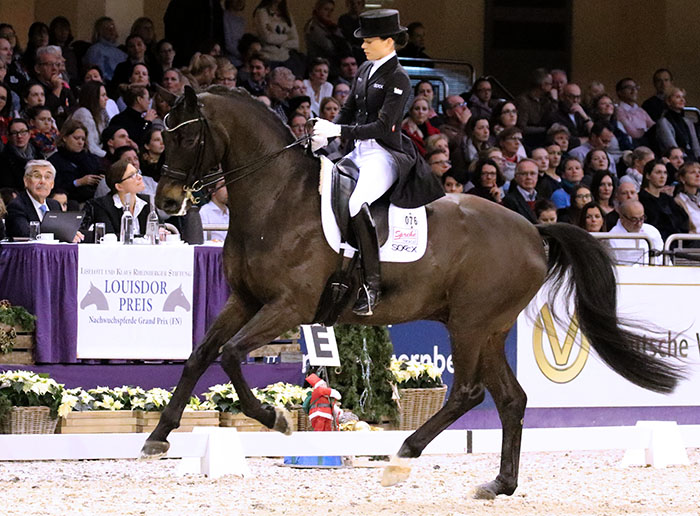
Kristina Bröring-Sprehe and her Desperados son, Destiny
It was a bit of a Desperados (De Niro / Wolkenstein II) celebration at this year’s Frankfurt show. The stallion himself looked great in his return from injury in the Grand Prix with Kristina Bröhring-Spehe, while Kristina rode the Desperados son, Destiny to second place in the Louisdor, a modified Grand Prix for younger horses, and Isabell took second in the Burg-Pokal with Descolari.
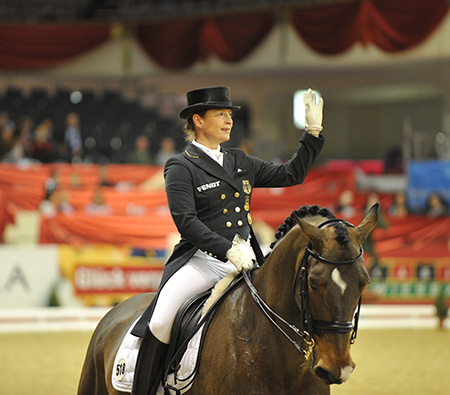
Ms Werth will never die wondering what would have happened if she gave it a try, they too were up and firing for the final. The halt was a bit messy, but the trot diagonal made up for that, truly wonderful half passes, big, powerful walk and a great canter. 75.268 to finish in second place, although two of the judges thought them the best, one fourth, one second, and one had them sixth. Really the judging at this year’s Frankfurt show was all over the place…
The most influential sire of this year’s Burg-Pokal finalists was this year’s Hanoverian stallion of the year, Belissimo (Beltain / Romadour II). He was represented by his daughter, Bohemian Rhapsodie (out of a De Niro mare), by Brianna (by the Belissimo son, Bvlgari out of a World Magic mare), and Bonamour (by another son, Bonifatius/Lauries Crusador xx).
Both Bohemian Rhapsodie and Brianna were ridden by one of the most elegantly effective riders in the world, Kira Wulferding. As I stood there watching Kira warm in Rhapsodie for the final, I decided it had been worth the 30 hours flight time, just to see such a wonderful exhibition of simple, logical, gymnastic progression.
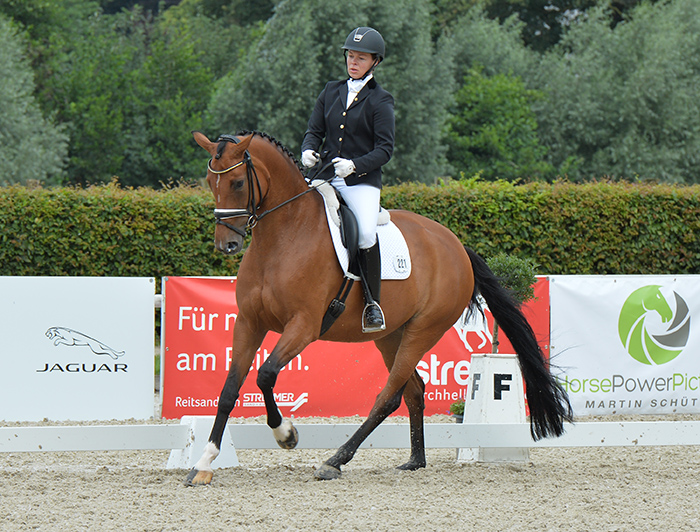
Brianna qualifying for the 2017 Bundeschampionat, only 18 months ago…
Seven-year-old Brianna, who won the hearts of the crowd, and three of the five judges (one other had her 8th!) in the warm up class, only made it to the Frankfurt final by accident. Brianna was taken to the Redefin qualifier to keep her older stablemate, Bohemian Rhapsodie, company. She won the qualifier at Redefin, and then the warmup class in the big Frankfurt hall. It was lovely deliberate, rhythmic work, expansive without being spectacular, exciting because it was so correct and harmonious. It was great to see Kira’s mentor for just on 20 years, Wolfram Wittig, awarded the title of Riding Master at this year’s show…
In the Final, Brianna slipped to 6th place, although she was 2nd ranked by Dietrich Plewa, whose judging throughout the show was both consistent and easy to follow. Once again, Kira elected to ride the older Bohemian Rhapsodie first, and they were literally that, first out, with another stunning ride, but we all know that it is almost impossible to win from that position, and the pair finished fourth, behind Bluetooth, who was better in the final, but again over-scored. Hubertus and Bonamour finished fifth, again with rankings from 3rd (twice) to 9th.
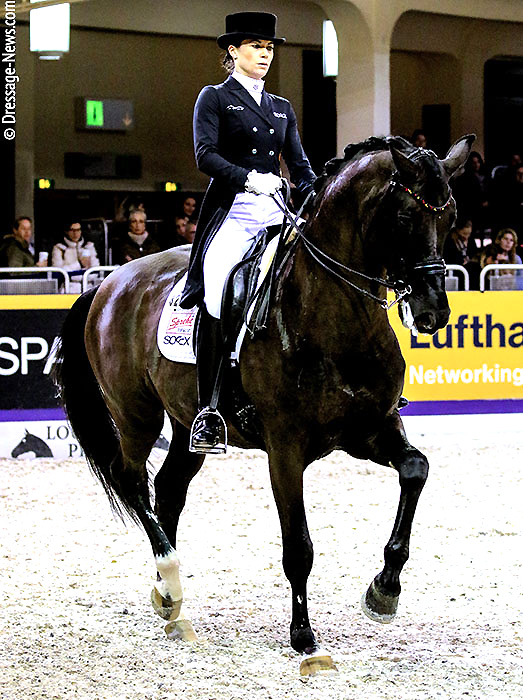
Desperados, back in action
The Grand Prix at Frankfurt is usually not its best class, but this year, it had added gloss, with Tina Bröring-Sprehe bringing Desperados back to the competition ring, and Isabell Werth stepping out on Don Johnson. But it was a shining new star on the dressage firmament that took first place, Blue Hors Zepter ridden by Daniel Bachmann Andersen. The ten-year-old gelding (FEI database persons please note, no longer a stallion) is by the stallion Daniel rode at Tryon, Zack, out of a mare by the Weltmeyer son, Wolkentanz II. Blue Hors Zack is essence of Dutch dressage breeding – by Rousseau (Ferro / Roemer) out of a Jazz mare. With horses like Zepter, it is quite apparent that Blue Hors has gone from being a showcase for stallions bred elsewhere, to a powerhouse of breeding in its own right. Zepter finished first on 78.543, with Desperados, 2nd, 76.891, and Jessica von Brewdow-Werndl’s Dutch mare, Zaire-E (Son de Niro / Jazz) third on 76.043, with Isabell having to settle for fourth on Don Johnson (Don Frederico / Warkant) with 75.087.
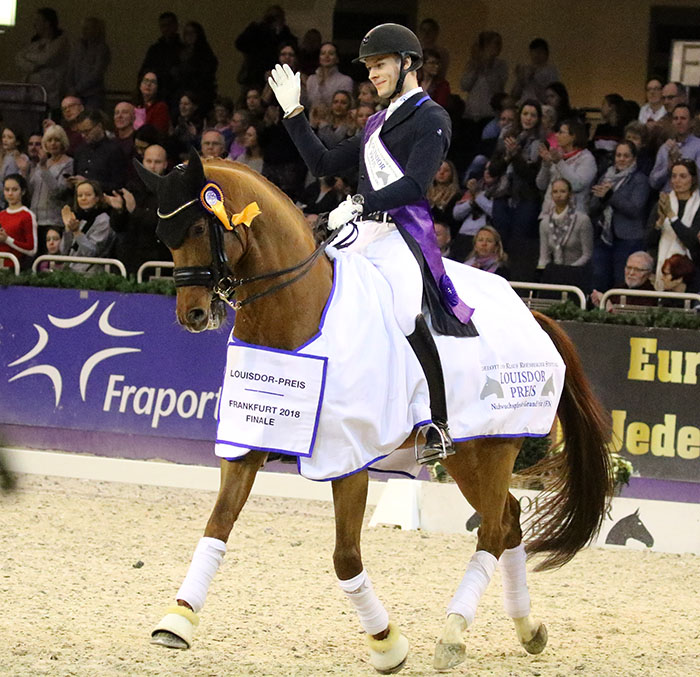
Daniel was also the star of the other major young horse showcase, the Louisdor Preis for Grand Prix horses aged eight to ten years old, taking out the class in grand style on Blue Hors Veneziano. This stallion is again royally bred, by the current flavour of the month in Holland and Germany, Vivaldi (Krack C / Jazz) he is out of the Donnerhall mare Fabina, who is out of Fiesta (Pik Bube I / Unkenruf) which makes Fabina a full-sister to the first real stallion star at Blue Hors, Don Schufro. I understand that Veneziano has been withdrawn from the breeding line-up at Blue Hors, since he is a carrier of the WFFS syndrome, which is not great news for mare owners, but very good news for young Daniel who no longer has to juggle breeding and competition careers…
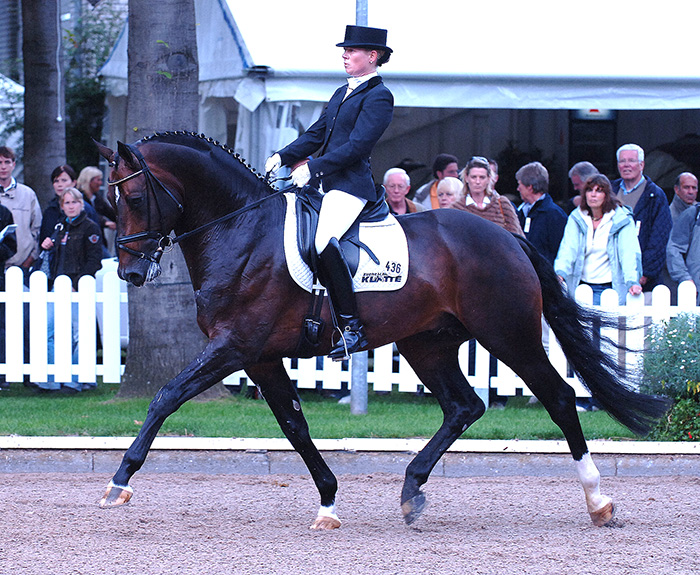
Farewell, the sire of Famoso
Second place to Famoso OLD (Farewell III / Welt Hit II) who went into the final red hot favourite with Benjamin Werndl. Benjamin had just finished explaining in the after test interview (why do reports from Olympia and the new Grand Prix lite, held a week after Frankfurt, breathlessly highlight the ‘breakthrough’ of having in-the-arena after-the test-interviews, when Kim Kreling has been doing them for years at Frankfurt?)that he blew the final by letting the pressure of being favourite get to him, when the scores went up, and there were three judges who still thought Famoso had won, despite the glaring mistakes!
Third to Kristina Bröring-Sprehe and Destiny OLD (Desperados / Sandro Hit), and fourth to Hubertus Schmidt and Escolar (Estobar NRW / Fürst Piccolo) who still looks very very special even if he is struggling with piaffe at the moment.
For mine, Frankfurt is a show that has everything, and this year, the city added a special yuletide touch, on the Saturday morning everything was gently covered with snow…
